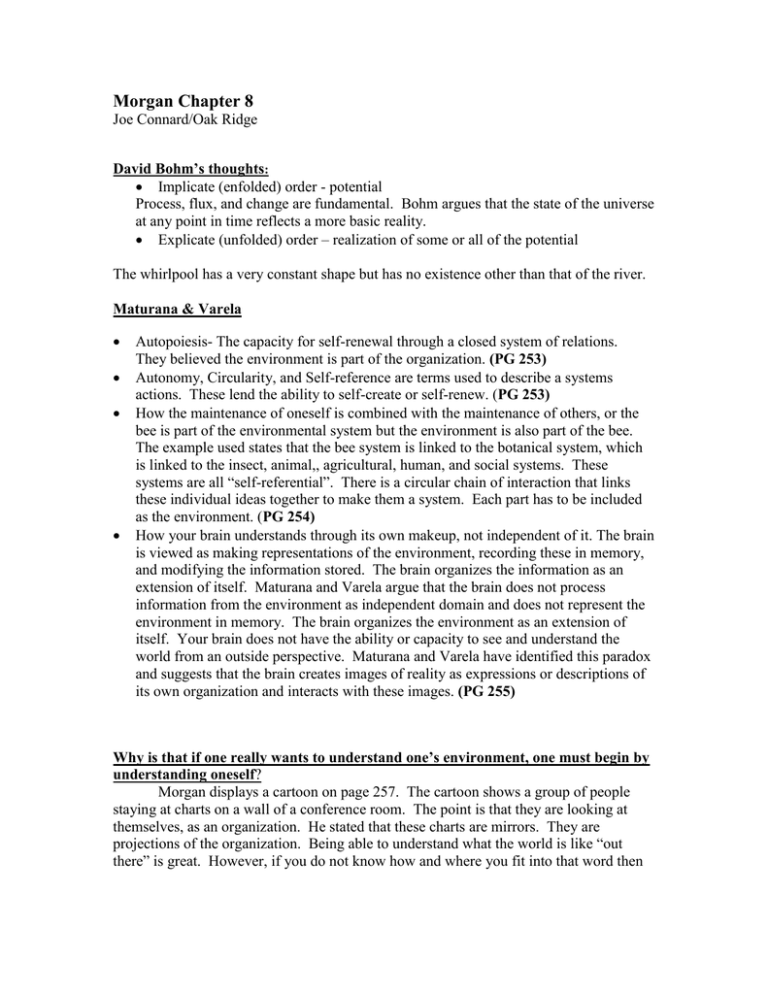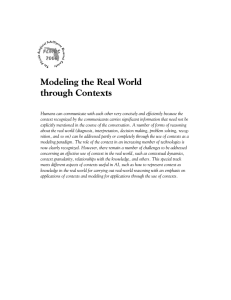Morgan Chapter 8
advertisement

Morgan Chapter 8 Joe Connard/Oak Ridge David Bohm’s thoughts: Implicate (enfolded) order - potential Process, flux, and change are fundamental. Bohm argues that the state of the universe at any point in time reflects a more basic reality. Explicate (unfolded) order – realization of some or all of the potential The whirlpool has a very constant shape but has no existence other than that of the river. Maturana & Varela Autopoiesis- The capacity for self-renewal through a closed system of relations. They believed the environment is part of the organization. (PG 253) Autonomy, Circularity, and Self-reference are terms used to describe a systems actions. These lend the ability to self-create or self-renew. (PG 253) How the maintenance of oneself is combined with the maintenance of others, or the bee is part of the environmental system but the environment is also part of the bee. The example used states that the bee system is linked to the botanical system, which is linked to the insect, animal,, agricultural, human, and social systems. These systems are all “self-referential”. There is a circular chain of interaction that links these individual ideas together to make them a system. Each part has to be included as the environment. (PG 254) How your brain understands through its own makeup, not independent of it. The brain is viewed as making representations of the environment, recording these in memory, and modifying the information stored. The brain organizes the information as an extension of itself. Maturana and Varela argue that the brain does not process information from the environment as independent domain and does not represent the environment in memory. The brain organizes the environment as an extension of itself. Your brain does not have the ability or capacity to see and understand the world from an outside perspective. Maturana and Varela have identified this paradox and suggests that the brain creates images of reality as expressions or descriptions of its own organization and interacts with these images. (PG 255) Why is that if one really wants to understand one’s environment, one must begin by understanding oneself? Morgan displays a cartoon on page 257. The cartoon shows a group of people staying at charts on a wall of a conference room. The point is that they are looking at themselves, as an organization. He stated that these charts are mirrors. They are projections of the organization. Being able to understand what the world is like “out there” is great. However, if you do not know how and where you fit into that word then you will be forced to react to your environment and could be forced out. Since you are part of the environment, you have to know your current role, within that environment. What is the point being made by the fact that analogue watch makers did not understand the environment because they did not see digital technology as part of it…The same can be said of those in the typewriter business or those in the horse and carriage business. The point being made is that you have to envision your entire environment, not just your little corner. If you allow yourself to become egocentric and you close off any thinking that contradicts this then you may be closing off your future. These industries identified unrealistic identities for themselves and this lead to their demise, since they could not see the big picture and how they could evolve and fit into it. They viewed themselves as watch makers and typewriter makers only. Pollution and health problems created by toxins can likely eliminate or severely constrain the operations of an industry over time. This is an example of egocentricism. The companies that make toxic chemicals create side effects. These companies create hazardous waste and long term problems that they do not typically acknowledge. Their interest lies in making profits. The toxins, as well as the social issues, will likely limit or eliminate their profits long-term. Champion Paper is an example. The company has made probably billions of dollars from their paper plant. They are now forced to spend millions to clean up their mess. They have to spend millions on legal fees, fines, etc. Attractors exist as part of the latent potential of a complex nonlinear system Attractors are random disturbances that exist in non-linear systems, ecologies, and organizations. These random disturbances produce unpredictable events that cause chaos. Morgan states that “coherent order always emerges out of the randomness”. Morgan uses the example of sitting on the veranda as a way of explaining what attractors are. The example states that you are sitting on the veranda and listening to the sounds of nature when from inside your house you begin to hear various noises form various appliances. These noises are the attractors. Here you are first focused on the sounds outside you do not hear the noises from inside. They are present, you just are not listening. After they have been heard, you have a difficult time removing them. Butterfly effect The butterfly describes a theory that states that one small change can have significant impact on other things. The example is that a butterfly flaps their wings in Peking and this can somehow change the weather patterns in the Gulf of Mexico. The theory does not state that every time a butterfly flaps this effect will occur. What is states is that each time something, like the butterfly flapping, occurs this action can effect another action that can effect another action and so forth. Ultimately, creating the weather pattern in the Gulf of Mexico to be altered. The butterfly does not cause the end result. If it did then that would be an example of linear logic. The butterfly simply triggers the change. Basketball example The example shows how there can be multiple points of contact in a process but if they work together then the movement is almost singular. The timing is the primary key to aid in avoiding chaos. Chaos is unmanageable and, therefore, the timing and complexity of decision are key. Management’s role is to shape and create “contexts” in which appropriate forms of self-organization can occur. The key point is to remember that the manager helps create the conditions under which the new contexts can occur. The manager cannot be in control, while acting on the insights of chaos and complexity theory. Jeffrey Goldstein believes that the organization can resist the new contexts. The new contexts must be created using new understandings, which can be accomplished by introducing new ideas. New contexts can break the hold of dominant attractor patterns in favor of new ones New contexts can break the hold if the manager is successful in “pulling” the latent energies of the system to a point where they can organize into a new form. The manager must realize the natural resistance and be prepared to “pull” the organization along. Small changes produce large effects when they change the dominant attractor patterns. Using the “Butterfly” example, we can see how a small change can change larger things. Human beings have the ability to reflect on their contexts an to choose the points at which they intervene. What Yin and yang have to do with balance Yin and yang represent balance. Each is the complete opposite of the other. Each is also the complimentor of the other. You cannot appreciate one if you do not have the other. Yin is dark and yang is light. They exist together but separately and have the seed of the other already placed inside. Paradoxes can create bi-furcation point, force the decision and cause great release and thus change These tensions are between the status quo and the alternatives. If allowed, these can lead to the idea that the current situation is acceptable compared to risking the down side of the new idea. Morgan’s example discussed the hospital emergency room. His example was that if the physicians or administrators feel that the community based services will lead to “poorer quality”, “less control”, “falling standards”, and “loss of power” then they will reinforce the idea that the current situation is better than the alternatives. The “chaos manager” has to be able to recognize these “forks in the road” and create the appropriate contexts. Dialectical reasoning forces a confrontation of opposites and powerful forces are released The example shows how Marxist ideologies seemed to be “passé”, with the collapse of the USSR and Eastern Europe. Marx’s social analysis can be understood by looking at three key points: The Mutual struggle, or unity of opposites, The negotiation of the negation, The transformation of quantity into quality.
